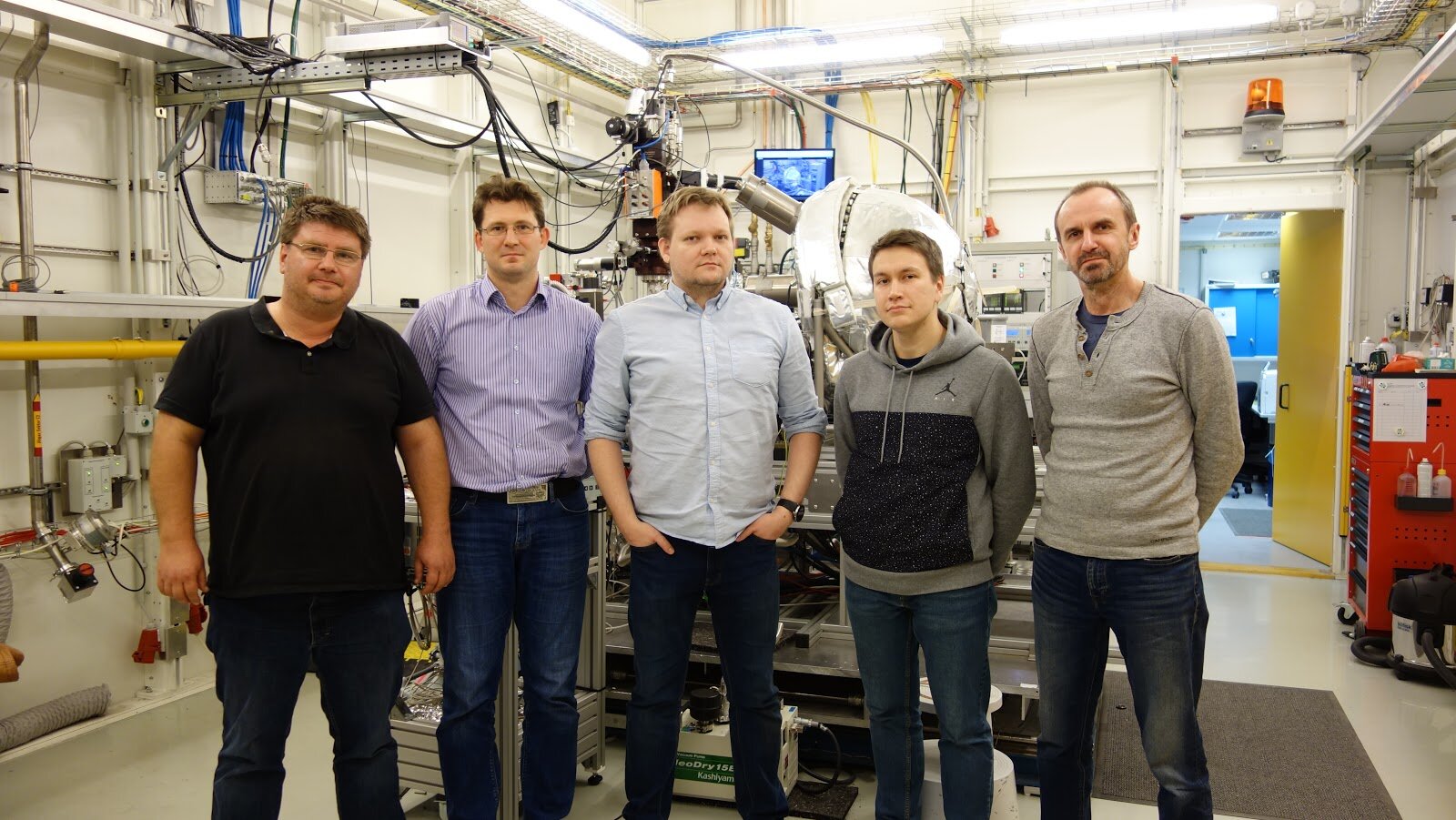
Posted on 12/26/2019 10:01:52 AM PST by Red Badger

Members of the research team that conducted the experiment, standing in front of the high-energy X-ray photoemission spectroscopy setup at the PETRA III synchrotron in Hamburg, Germany. Left to right: Andrei Gloskovskii, Yury Matveyev, Dmitry Negrov, Vitalii Mikheev, and Andrei Zenkevich. Credit: Andrei Zenkevich/MIPT
====================================================================
Researchers from the Moscow Institute of Physics and Technology, along with their colleagues from Germany and the U.S., have achieved a breakthrough in nonvolatile memory devices. The team came up with a unique method for measuring the electric potential distribution across a ferroelectric capacitor, which could lead to the creation of memory orders of magnitude faster than current flash and solid-state drives, withstanding 1 million times as many rewrite cycles. The paper was published in Nanoscale.
Hafnium dioxide-based memory is based on a dielectric already known to the microelectronics industry. Subjected to temperature treatment and alloying, a nanometer-scale hafnium dioxide layer can form metastable crystals that possess ferroelectric properties—that is, they "remember" the direction of the electric field applied to them.
The new memory cell is a zirconium-hafnium oxide film 10 nanometers thick interlaid between two electrodes. Its structure resembles a conventional electric capacitor. To make ferroelectric capacitors usable as memory cells, their remnant polarization has to be maximized; and to ensure that, engineers need a detailed understanding of the processes that occur in the nanofilm. This involves explaining how the electric potential is distributed across the film following voltage application and polarization reversal. Since the discovery of a ferroelectric phase in hafnium oxide 10 years ago, the potential distribution at the nanoscale has only been modeled, but not directly measured. The latter has been reported in the recent paper in Nanoscale.
The team employed a technique known as high-energy X-ray photoemission spectroscopy. The specialized methodology developed at MIPT relies on the so-called standing-wave mode of the powerful monochromatic X-ray beam, which requires a synchrotron light source to produce. The machine used in the study is located in Hamburg, Germany. It was used to perform measurements on the hafnium oxide-based memory cell prototypes manufactured at MIPT.
"If used for the industrial production of nonvolatile memory cells, the ferroelectric capacitors developed in our lab could endure 10 billion rewrite cycles, which is 100,000 times more than state-of-the-art flash drives can survive," said study co-author Andrei Zenkevich, who heads the Laboratory of Functional Materials and Devices for Nanoelectronics at MIPT.
A further advantage of ferroelectric memory devices is that external radiation has absolutely no effect on them, unlike their semiconductor-based analogues. This means that the flash-like memory of the future could even weather cosmic ray exposure and operate in outer space.
Ping!...................
You know, it is hard to believe that memory is perishable and can wear out, but it is...
Yes, very few realize that their SSD’s are doomed from the day they buy them...................
It also makes me wonder how many older machines are running RAM with quite diminished capacity?
Many, many. But I think they would show up as slow as molasses in January.....................
I remember investigating ferroelectrics for this sort of thing about 30 years ago or so. Maybe now it’s ready for prime time.
Five Russians in a German lab...
What a mix of social, educational, political, and scientific implications and outcomes.
You coulda been a contendah!....................
Yeah, the microSD card on my phone died this morning.
The team employed a technique known as high-energy X-ray photoemission spectroscopy. The specialized methodology developed at MIPT relies on the so-called standing-wave mode of the powerful monochromatic X-ray beam, which requires a synchrotron light source to produce.
...
Now they need to find out how to fit one of those in a phone.
Honestly, I have never thought to run a memory test on old RAM. I always tend to blame other stuff first and never considered this as a possibility for the drag. :)
Thank you for posting this, indirectly it made me realize I really should run memory tests more often. lol
Sounds like it might be EMP-proof.
They need to make them bigger again! A big 32 gig card is always better than a small 32 gig card. More surface, longer wear. lol
Thanks Red Badger. Micron? Down a tick. :^) Interesting looking idea, looks like a working prototype is 5 years out (at least). 3D XPoint (jointly dev by Intel and Micron) was hard to do, and has finally come to market. Scaling production will probably be sped up a hair, and this new development work will be wrapped up in licensing in a big hurry to keep it out of Chinese hands.
“You coulda been a contendah!”
I meant, as a developer that would use the product, not developing it. Whenever it comes out, the sooner the better. 30+ years is a long time to wait.
Look up memtest86.exe, iirc...
Yep, Hafnium is a neutron absorber.............
....and a lot easier to handle. MicroSD cards are really easy to lose!...............
Disclaimer: Opinions posted on Free Republic are those of the individual posters and do not necessarily represent the opinion of Free Republic or its management. All materials posted herein are protected by copyright law and the exemption for fair use of copyrighted works.